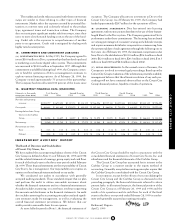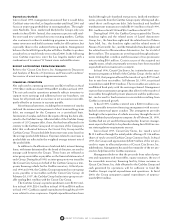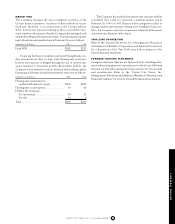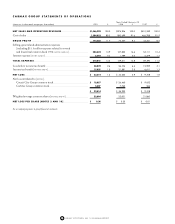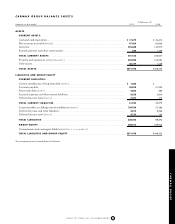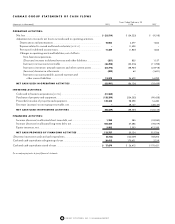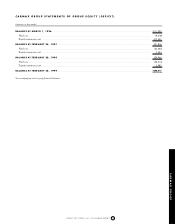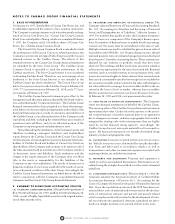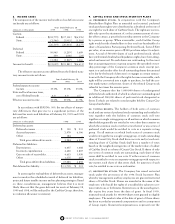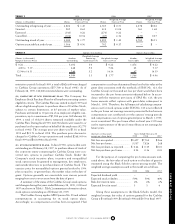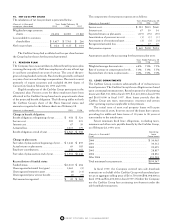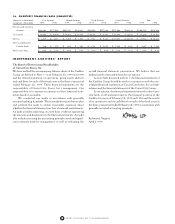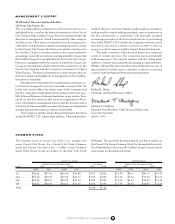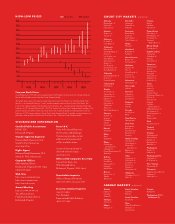CarMax 1999 Annual Report Download - page 75
Download and view the complete annual report
Please find page 75 of the 1999 CarMax annual report below. You can navigate through the pages in the report by either clicking on the pages listed below, or by using the keyword search tool below to find specific information within the annual report.
(G) INTANGIBLE ASSETS:
Amounts paid for acquired businesses in
excess of the fair value of the net tangible assets acquired are
recorded as goodwill, which is amortized on a straight-line basis
over 15 years, and covenants not to compete, which are amortized
on a straight-line basis over the life of the covenant not to exceed
five years. Both goodwill and covenants not to compete are
included in other assets on the accompanying CarMax Group bal-
ance sheets. The carrying value of intangible assets is periodically
reviewed by the Company and impairments are recognized when
the expected future undiscounted operating cash flows derived
from such intangible assets are less than the carrying value.
(H) PRE-OPENING EXPENSES:
Expenses associated with the open-
ing of new stores are deferred and amortized ratably over the period
from the date of the store opening to the end of the fiscal year.
(I) INCOME TAXES:
Income taxes are accounted for in accordance
with SFAS No. 109, “Accounting for Income Taxes.” Deferred
income taxes reflect the impact of temporary differences between
the amounts of assets and liabilities recognized for financial
reporting purposes and the amounts recognized for income tax
purposes, measured by applying currently enacted tax laws. A
deferred tax asset is recognized if it is more likely than not that a
benefit will be realized.
(J) DEFERRED REVENUE:
The CarMax Group sells service con-
tracts on behalf of unrelated third parties and, prior to July 1997,
sold its own contracts at one location where third-party warranty
sales were not permitted. Contracts usually have terms of coverage
between 12 and 72 months. All revenue from the sale of the
CarMax Group’s own service contracts is deferred and amortized
over the life of the contracts consistent with the pattern of repair
experience of the industry. Incremental direct costs related to the
sale of contracts are deferred and charged to expense in proportion
to the revenue recognized. Commission revenue for the unrelated
third-party service contracts is recognized at the time of sale.
(K) SELLING, GENERAL AND ADMINISTRATIVE EXPENSES:
Oper-
ating profits generated by the finance operation are recorded as a
reduction to selling, general and administrative expenses.
(L) ADVERTISING EXPENSES:
All advertising costs are expensed
as incurred.
(M) NET LOSS PER SHARE:
On December 15, 1997, the Company
adopted SFAS No. 128, “Earnings per Share.” All prior period loss
per share data presented has been restated to conform with the
provisions of SFAS No. 128.
Net loss per share is computed by dividing the net loss
attributed to CarMax Stock by the weighted average number of
common shares outstanding. Diluted net loss per share is not cal-
culated since CarMax has a net loss for the periods presented.
(N) STOCK-BASED COMPENSATION:
On March 1, 1996, the
Company adopted SFAS No. 123, “Accounting for Stock-Based
Compensation.” The Company has elected to continue applying
the provisions of the Accounting Principles Board Opinion No.
25, “Accounting For Stock Issued to Employees,” and to provide
the pro forma disclosures of SFAS No. 123.
(O) DERIVATIVE FINANCIAL INSTRUMENTS:
The Company
enters into interest rate swap agreements to manage exposure to
interest rates and to more closely match funding costs to the use
of funding. Interest rate swaps relating to long-term debt are clas-
sified as held for purposes other than trading and are accounted
for on a settlement basis. To qualify for this accounting treatment,
the swap must synthetically alter the nature of a designated under-
lying financial instrument. Under this method, payments or
receipts due or owed under the swap agreement are accrued
through each settlement date and recorded as a component of
interest expense. If a swap designated as a synthetic alteration
were to be terminated, any gain or loss on the termination would
be deferred and recognized over the shorter of the original con-
tractual life of the swap or the related life of the designated long-
term debt.
The Company also enters into interest rate swap agreements
as part of its asset securitization programs. Swaps entered into by
a seller as part of a sale of financial assets are considered proceeds
at fair value in the determination of the gain or loss on the sale. If
such a swap were terminated, the impact on the fair value of the
financial asset created by the sale of the related receivables would
be estimated and included in earnings.
(P) RISKS AND UNCERTAINTIES:
The CarMax Group is a used-
and new-car retail business. The diversity of the CarMax Group’s
customers and suppliers reduces the risk that a severe impact will
occur in the near term as a result of changes in its customer base or
sources of supply. However, due to the CarMax Group’s limited
overall size, management cannot assure that unanticipated events
will not have a negative impact on the Group.
The preparation of financial statements in conformity with
generally accepted accounting principles requires management to
make estimates and assumptions that affect the reported amounts
of assets, liabilities, revenues and expenses and the disclosure of
contingent assets and liabilities. Actual results could differ from
those estimates.
(Q) RECLASSIFICATIONS:
Certain amounts in prior years have
been reclassified to conform to classifications adopted in fiscal 1999.
3. CORPORATE ACTIVITIES
The CarMax Group’s financial statements reflect the application
of the management and allocation policies adopted by the board
of directors to various corporate activities, as described below:
(A) FINANCIAL ACTIVITIES:
Most financial activities are man-
aged by the Company on a centralized basis. Such financial activi-
ties include the investment of surplus cash and the issuance and
repayment of short-term and long-term debt. Allocated invested
surplus cash of the CarMax Group consists of (i) Company
cash equivalents, if any, that have been allocated in their entirety
to the CarMax Group and (ii) a portion of the Company’s cash
equivalents that are allocated between the Groups. Investment of
surplus cash from the offering has been allocated to the CarMax
Group. Allocated debt of the CarMax Group consists of (i)
Company debt, if any, that has been allocated in its entirety to the
CarMax Group and (ii) a portion of the Company’s pooled debt,
which is debt allocated between the Groups. The pooled debt
bears interest at a rate based on the average pooled debt balance.
CARMAX GROUP
CIRCUIT CITY STORES, INC. 1999 ANNUAL REPORT 73


